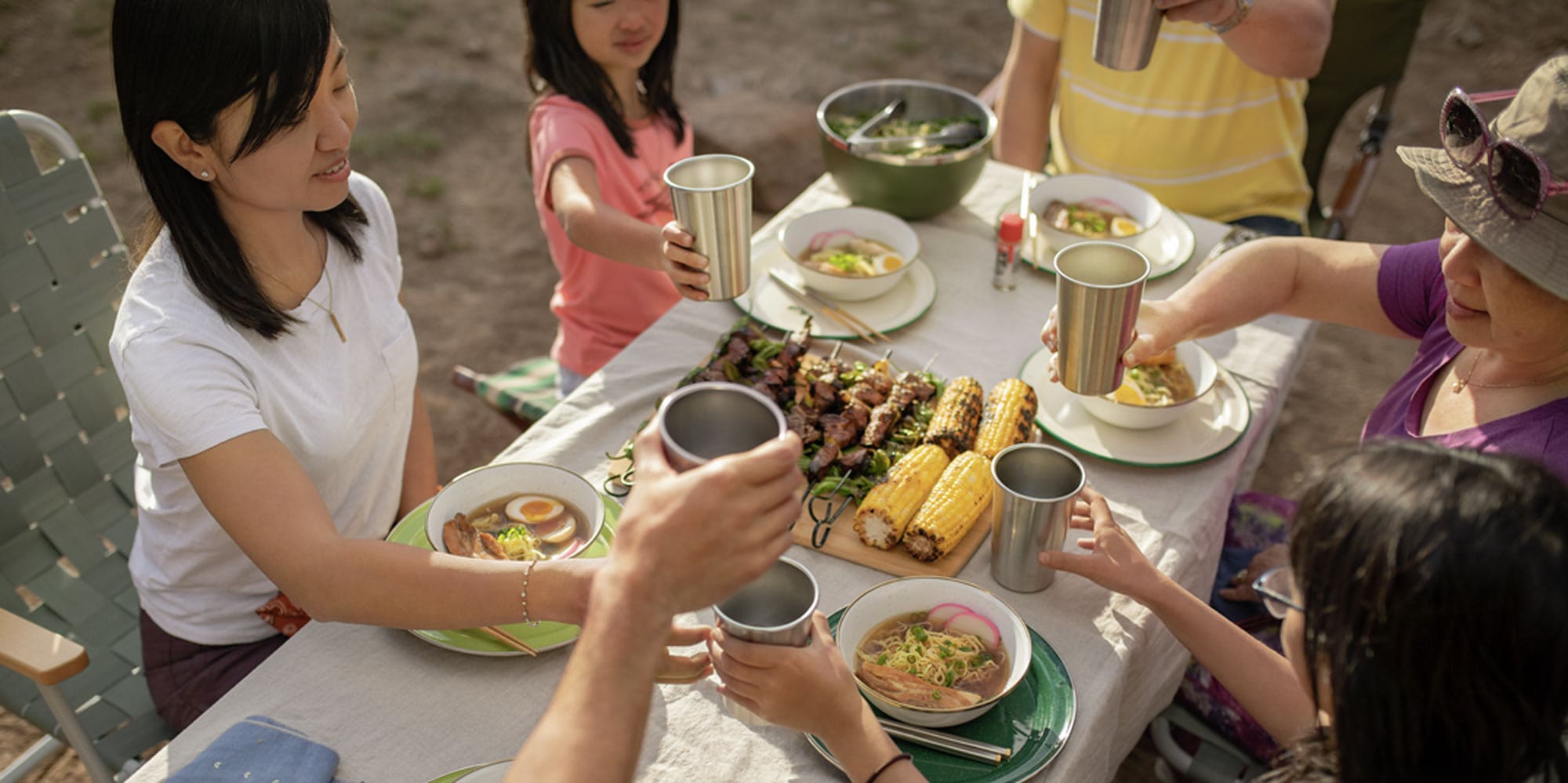There are so many ways to enjoy time outside. This is one of many unique stories we’re sharing as part of our effort to highlight the Limitless Sides to Outside.
Mark Toguchi grew up in Alaska. Every weekend in the summer, he and his extended family, including aunts, uncles and cousins, would go camping and fishing for salmon. They’d spread out in several tents and RVs along the river. “We could just camp out right on the side of the river and set up our tents and the fire pits and so during the day we would be fishing just right off the campsite,” he says.
His wife, Rowena, didn’t go on her first hike until college. Her boss at the time invited her on a hike at Mount Index outside of Seattle. “I was like, ‘Hiking? What’s that?’” Rowena says. “She took us out. In fact, she invited my parents and my aunt. It was beautiful. She packed us lunch and snacks and everything. I fell in love with hiking after that.”
Now that they have a family, the couple has been creating their own camping traditions with their two daughters and Rowena’s parents, Henry and Peggy Wong. Many moments revolve around sharing meals outdoors and telling stories around the campfire. The menu varies depending on their mood. They would dig up oysters on Northwest beaches, shuck them and eat them raw, or grill up clams they harvested. Other times, they’d bake potatoes, grill steaks or skewers of chicken, or roast marshmallows for s’mores. Or Mark, who is Japanese, would cook up a pot of chili and put his own spin on the Western dish, adding curry spices to beans and beef and serving it with steamed rice just like the Japanese beef curry that he grew up eating.
On their outings, you can find Rowena’s father, Henry Wong, tending to the charcoal and wood fires. Like his son-in-law, Henry is an avid cook, and the two would often take turns preparing meals—Mark cooking Japanese dishes and Henry serving up Cantonese favorites. Growing up in Hong Kong, Henry took part in the Boys Scouts for 10 years and developed a love for the outdoors, especially cooking and building fires. His favorite thing to cook outside is a dish he calls “the muddy chicken”—though he hasn’t prepared it in decades.
Here’s how to do it: First, cover a chicken with mud. Then roast it in an open fire. When the mud has hardened into a shell, break it open. The feathers on the chicken fall off and you’re left with a tender and juicy chicken. Apparently, this dish has a rich history with various origin stories. (You can read more about it here and here.)
Henry’s wife Peggy is a big fan of his cooking. She says her connection to the outdoors has grown stronger as she has gotten older. “The older I grow, the more I want, I like, to be with the younger generations,” she says. “So, you feel a lot more motivated to move around, to do things, especially to go outdoors.”
On a recent camping trip to central Washington state, everyone in the family had a role at dinnertime. The girls helped prep salad and corn. Henry stoked the fire. Rowena and Mark did a bit of everything, and Peggy set a beautiful table. And then they sat down and enjoyed the outdoor meal together.
Read on to find recipes from the Toguchi’s recent camp dinner menu, or skip ahead:
- Tonkotsu Ramen
- Massaged Kale Quinoa Salad
- Niku Kushiyaki (Beef skewers)
- Grilled Shishito Pepper Skewers
- Grilled Corn
Tonkotsu Ramen
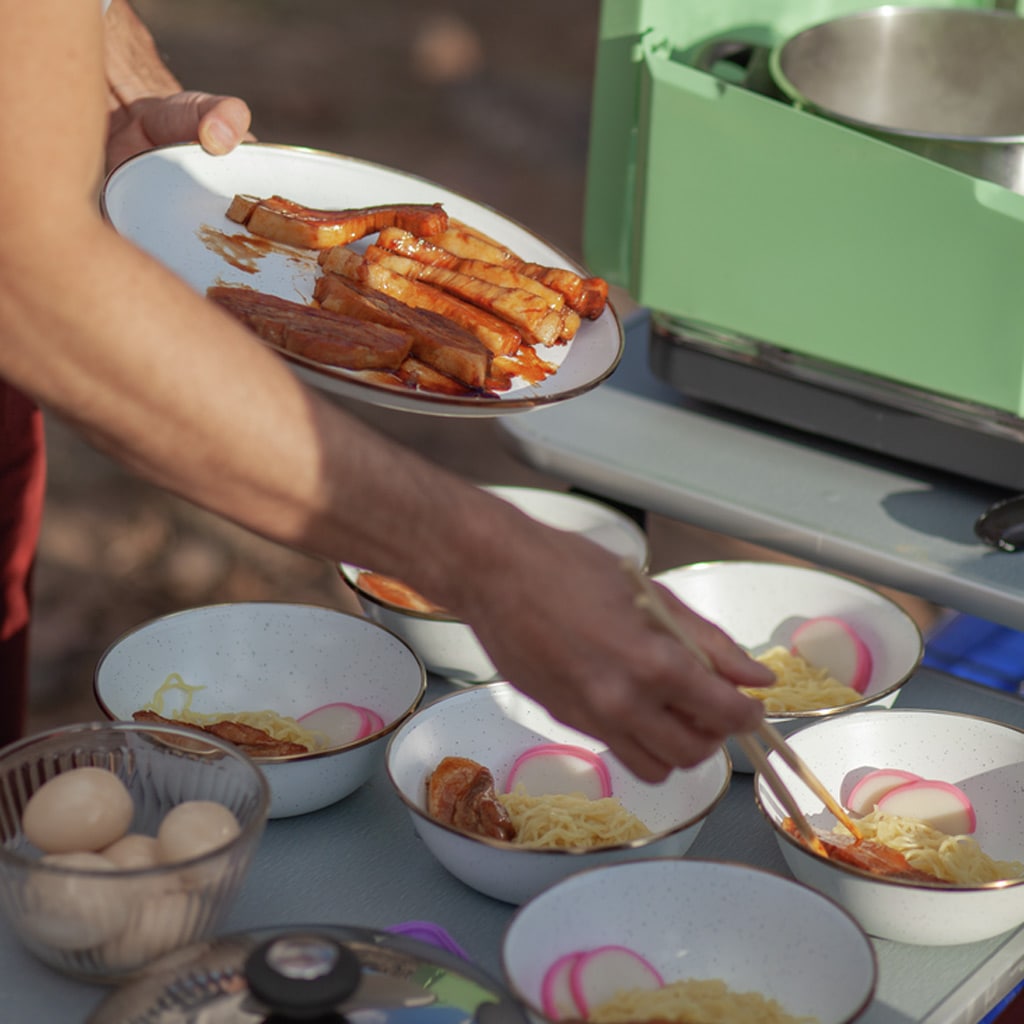
Ramen is meant to be eaten hot and quickly. A bowl of ramen should be finished within the first 10-13 minutes of it being served. As cooked ramen noodles sit in broth, they absorb liquid and begin to lose their toothsome texture. In Japanese culture, slurping ramen noodles is also highly encouraged. It helps cool off each mouthful of noodles just enough to enjoy while not getting burned. Slurping also acts as an aerator for the noodles and broth allowing the flavors to fully develop in your mouth. Just as one might aerate a nice bottle of wine, you would also aerate a delicious bowl of ramen by slurping your noodles!
Ingredients
- 3 packages – Sun Noodle tonkotsu ramen (pork flavor)
- Stewed Okinawan pork belly slices (sanmai niku) (see recipe below)
- Seasoning (Tare) for the pork belly:
- 6 tablespoons soy sauce
- 4 tablespoons sugar
- 2 tablespoons sake
- 2 tablespoons mirin (Japanese rice wine)
- 1 package Japanese fish cake (kamaboko)
- 2 stalks of green onions
- 6 ramen eggs (ajitsuke tamago)
- These are soft-boiled eggs marinated in a sweet/salty mixture. Any recipe works, but we like this recipe from J. Kenji López-Alt.
Directions at home
At home, prepare the stewed Okinawan pork belly, ramen eggs and Japanese fish cake.
Stewed Okinawan pork belly slices (sanmai niku)
To remove excess fat, place pork belly in pot with water. Bring water to a boil for 2-3 minutes. Drain and rinse pork. Add fresh water and pork to a clean pot; simmer for 1 hour and 15 minutes. Drain and rinse pork belly again. Cool to room temperature, cover and refrigerate until completely chilled. (This allows the pork to be easily sliced without shredding the meat.)
Meanwhile, combine all the seasoning ingredients in a small saucepan and simmer for 12-15 minutes or until the sauce is thickened and reduced by about half. Cool to room temperature. Transfer seasoning to a bottle.
Remove chilled pork from refrigerator and cut into 1/4” slices. Chill and refrigerate the sliced pork and seasoning.
Japanese fish cake (kamaboko)
Cut kamaboko into 1/4” slices. Chill and refrigerate.
Transfer pork belly, eggs and fish cake to an Igloo Cooler with ice before departing to camp.
Directions at camp
Boil water in two saucepans.
Thinly slice green onions for garnish. Reserve.
Place pork belly slices in a medium sauté pan. Heat on medium high heat over the Eureka Ignite 2-Burner Camp Stove until pork begins to sizzle. Flip pork and pour in the seasoning. Occasionally flip pork until the seasoning reduces to a glaze and the pork is browned and evenly coated.
In one saucepan, boil noodles per package instructions. In the other saucepan, mix soup base with water per package instructions. Reduce heat to a simmer.
Heat up ramen eggs and kamaboko in the hot soup using the wire mesh strainer. Reserve.
Drain noodles using a noodle strainer and divide into bowls. Add prepared broth into bowls.
Garnish with pork belly, ramen egg, kamaboko and green onion.
Serve and enjoy!
Massaged Kale Quinoa Salad
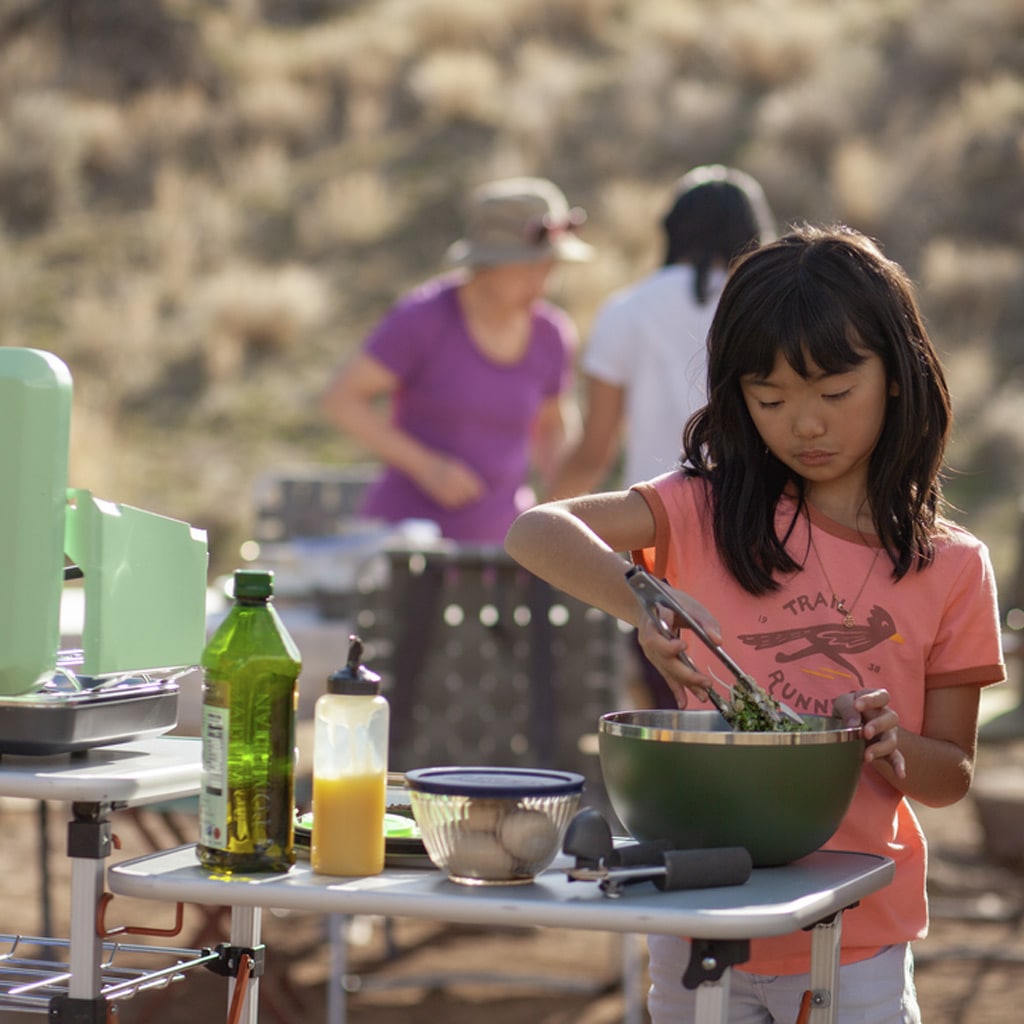
We could eat this salad every day. It is also by far our most requested potluck recipe from family and friends.
Ingredients
- 1 bundle of organic green kale (washed, dried and sliced very thin)
- 1 bundle of fresh dill (washed, dried, stemmed and roughly minced)
- 1/2 cup of quinoa, cooked per package instructions. (For more flavor, we cook the quinoa in chicken bone broth and a pinch of kosher salt instead of water for more flavor.)
- 1/3 cup pepitas (toasted on medium in a dry sauté pan until golden brown)
- 1/4 cup dried cranberries
- Shaved Parmigiano-Reggiano (as much as you like)
- Kosher salt and freshly ground black pepper
For the orange muscat champagne vinaigrette:
- 1/3 cup Trader Joe’s orange muscat champagne vinegar (or any champagne vinegar)
- 3 tablespoons honey
- 1/2 cup grapeseed oil
- 1/2 cup extra-virgin olive oil
- 1 tablespoon extra-virgin olive oil (for the kale)
Directions at home
For the vinaigrette:
In a bowl, mix honey and the orange muscat champagne vinegar until blended.
Slowly emulsify the oils into the honey-vinegar mixture using a handheld immersion blender or whisk. Pour vinaigrette into a bottle.
Chill and refrigerate.
Prepare all other salad ingredients in advance. Store each ingredient separately inside a bowl like the Hydro Flask 3 Qt Serving Bowl. Chill and refrigerate.
Transfer vinaigrette and salad ingredients to Igloo Cooler with ice before departing to camp.
Directions at camp
In the serving bowl, massage the kale with your hands and 1 tablespoon extra virgin olive oil until it stops making “crunching” sounds. (Massaging kale tenderizes its texture, making it easier to chew.)
Season with salt, pepper and vinaigrette to taste and mix.
Add the quinoa, dill, cranberries, cheese and mix.
Top the pepitas last to preserve their crunch.
Serve and enjoy!
Niku Kushiyaki (Beef skewers)
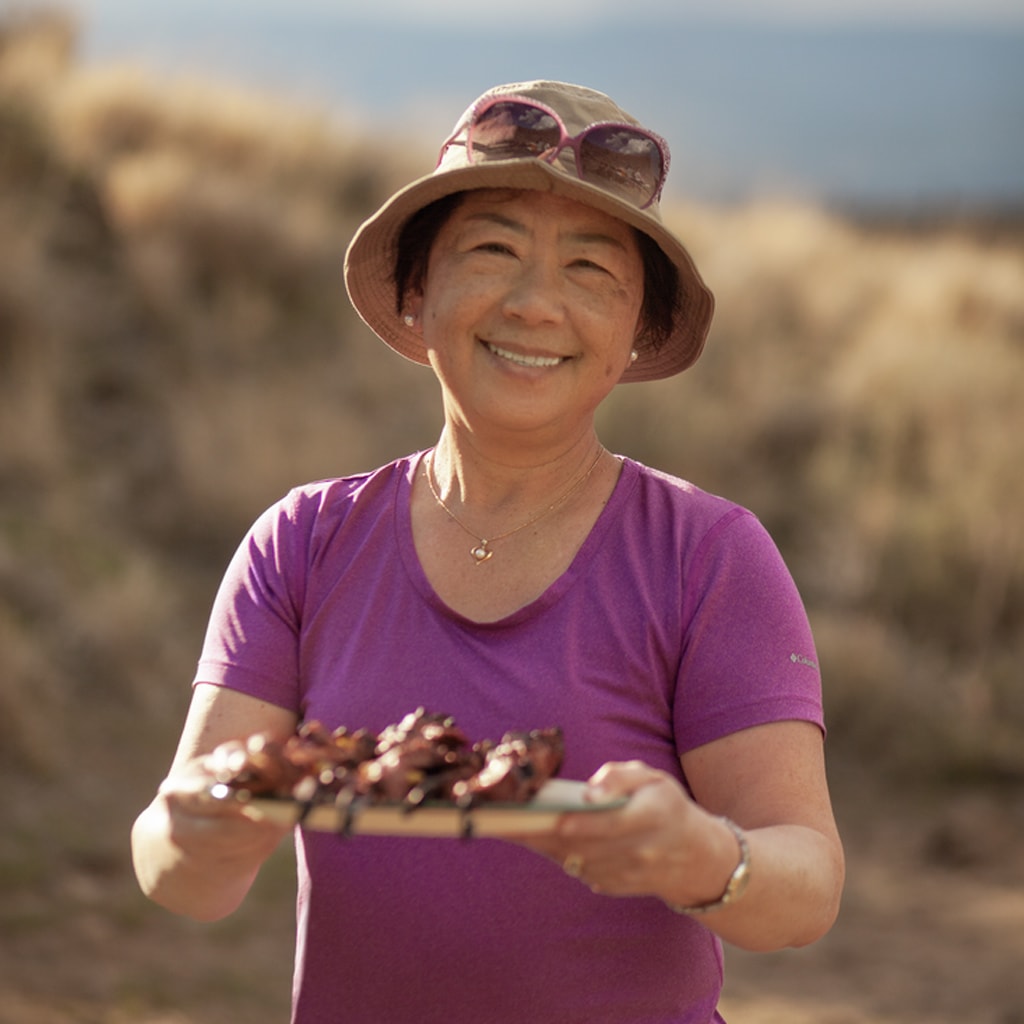
Ingredients
- 1 1/2 pounds of boneless rib-eye steak (trimmed of fat and cut into 1 1/4-inch cubes)
- Marinade: We like this recipe from Alton Brown, but you can use your favorite marinade
- Metal skewers
Directions at home
Place marinade and steak cubes into container. Cover with lid, refrigerate and marinate overnight.
Transfer to Igloo Cooler with ice before departing to camp.
Directions at camp
Prepare campfire with dry wood. Place grill grate over fire after flames die down and glowing embers are present.
Thread 4 cubes of beef onto each metal skewer.
Place beef skewers directly on grill grate for 2 minutes. Flip and grill for 2 minutes more or until beef is medium rare.
Serve and enjoy!
Grilled Corn
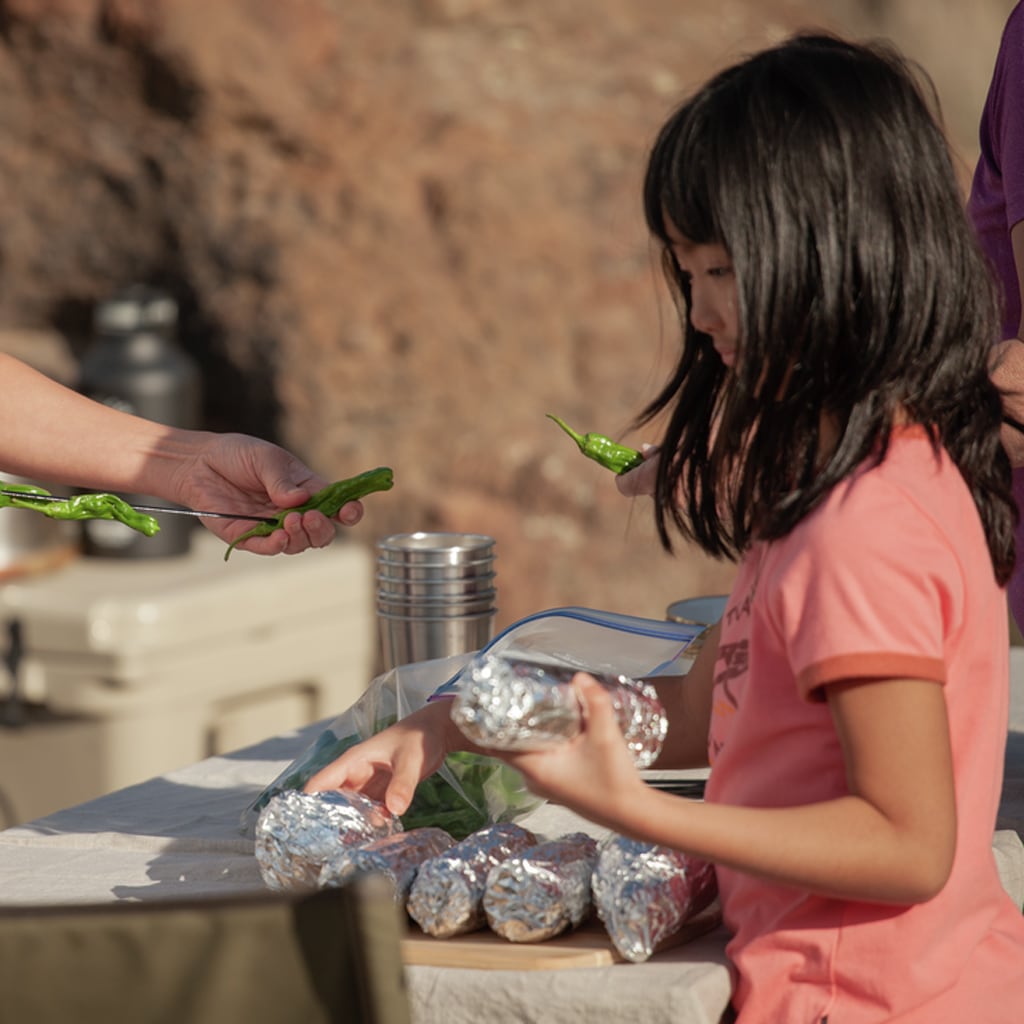
Ingredients
- 4 ears of shucked corn
- Maldon salt
- 2 tablespoons unsalted butter
Directions at camp
Prepare campfire with dry wood. Place grill grate over fire once flames die down and glowing embers are present.
Add corn and grill for about 8 minutes, turning frequently until nicely charred.
Smear butter onto corn and sprinkle with Maldon salt.
Serve and enjoy!
Grilled Shishito Pepper Skewers
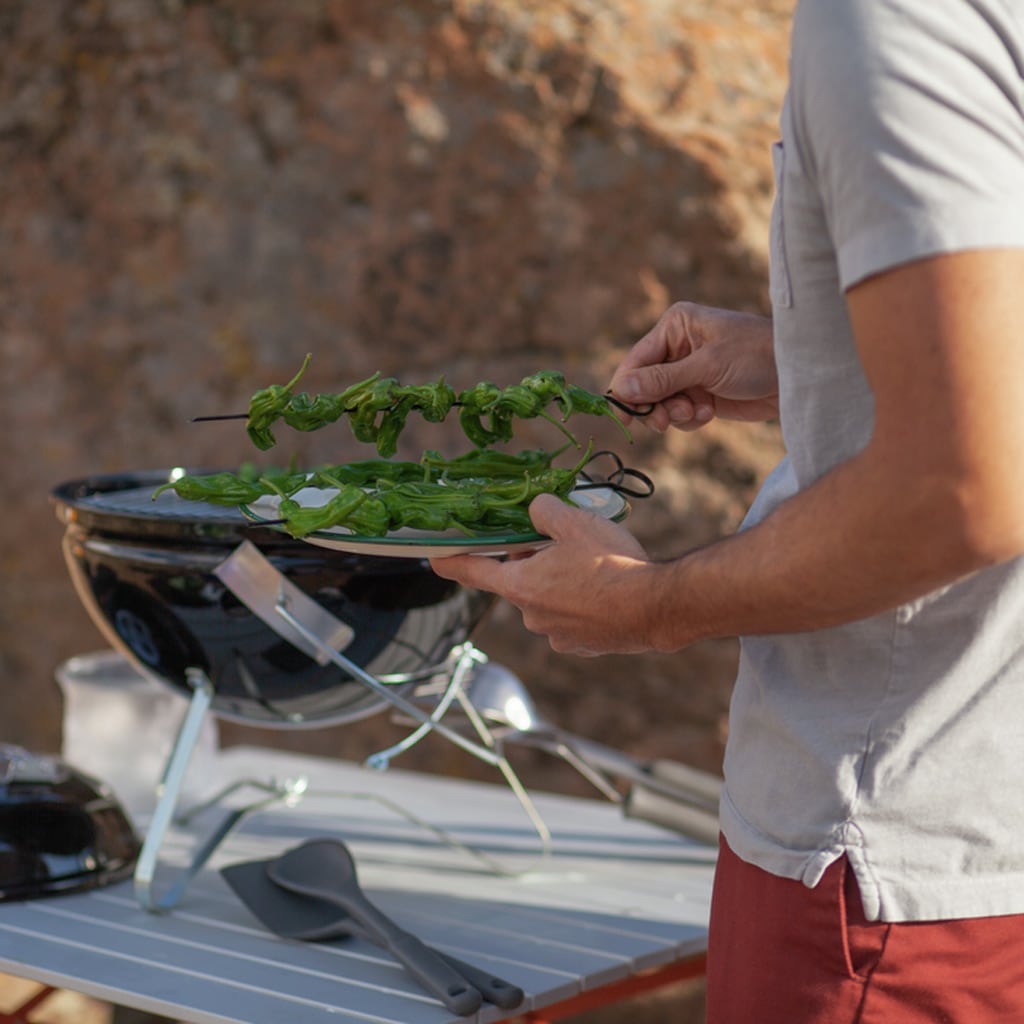
Shishito peppers are mostly mild and sweet, but you may occasionally encounter one that is very spicy. That unknown is all part of the fun.
Ingredients
- 1 pound shishito peppers
- Sea salt (preferably Maldon)
- 1 tablespoon extra virgin olive oil
Directions at home
Wash shishito peppers and dry.
Place peppers into container. Cover with lid, refrigerate and reserve.
Transfer to Igloo Cooler with ice before departing to camp.
Direction at camp
Prepare grill with charcoal and lighter fluid. Light the charcoal with a long match or lighter. Place grill grate onto grill once flames die down and charcoal is covered in white ash.
Thread shishito peppers crosswise onto metal skewers. Lightly brush peppers with olive oil.
Place shishito pepper skewers on Smokey Joe Grill for 2 minutes. Flip and grill for 2 minutes more or until peppers are blistered. Remove and season with salt.
Serve and enjoy!
